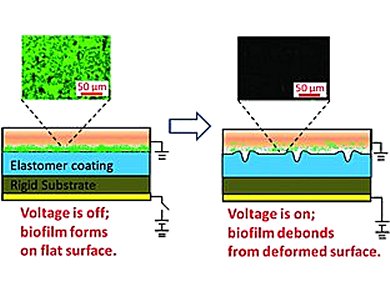Biological surfaces control biofouling through active deformation and motion. Cilia on the surface of respiratory tracts, e.g., constantly sweep out inhaled foreign particles that are sequestered in hydrated, protective mucus layers. Mollusks, corals, and many other marine organisms also use mucus sloughing and ciliary cleaning.
Gabriel P. López, Xuanhe Zhao, and colleagues, Duke University, Durham, NC, USA, created a general, bio-inspired approach for actively and effectively detaching micro- and macro-fouling organisms. Their simple elastomer surfaces are capable of dynamic deformation in response to external stimuli like electrical voltage, mechanical stretching, and air pressure.
For an electro-active antifouling coating, e.g., the team bonded films of a silicone elastomer, a rigid insulating substrate, and a metal foil together to form a trilayer laminate. The model marine bacterium Cobetia marina was allowed to form biofilms on the elastomer surfaces for 4 days. As a DC voltage was applied to the metal foil under the laminate, an electric field developed in the elastomer. When the electric field exceeds a critical value, the surface of the elastomer becomes unstable, deforming into a pattern of “craters”. This deformation detaches over 95 % of the Cobetia marina biofilm adhered to the elastomer surface, which is periodically actuated for 200 cycles within 10 minutes.
The bio-inspired dynamic surfaces can be fabricated over large areas through simple and practical processes. The mechanism is complementary with existing materials and methods commonly used in marine coatings and medical devices such as surface modification, controlled release, and micro- and nanotopography.
- Bioinspired Surfaces with Dynamic Topography for Active Control of Biofouling,
Phanindhar Shivapooja, Qiming Wang, Beatriz Orihuela, Daniel Rittschof, Gabriel P. López, Xuanhe Zhao,
Adv. Mater. 2013.
DOI: 10.1002/adma.201203374



